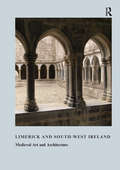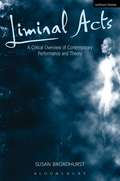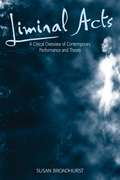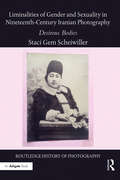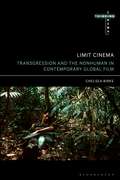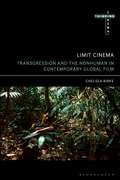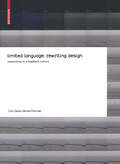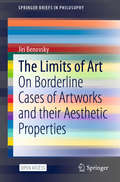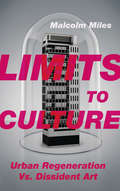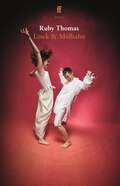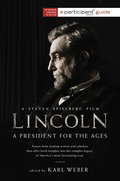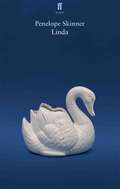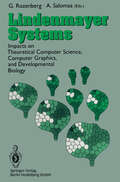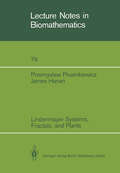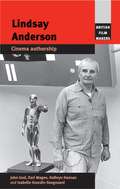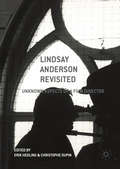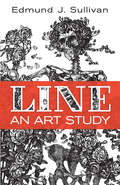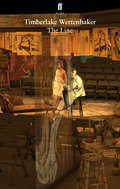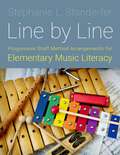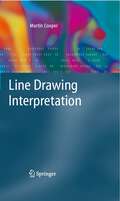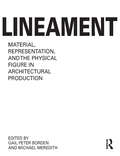- Table View
- List View
Limerick and South-West Ireland: Medieval Art and Architecture
by Roger StalleyThis book contains essays devoted to the medieval art and architecture of Limerick in the Munster province of South-West Ireland. It underpins the degree to which Irish craftsmen and builders engaged with the rest of Europe, and the nature of their relationship with English practice.
Limerick and South-West Ireland: Medieval Art and Architecture
by Roger StalleyThis book contains essays devoted to the medieval art and architecture of Limerick in the Munster province of South-West Ireland. It underpins the degree to which Irish craftsmen and builders engaged with the rest of Europe, and the nature of their relationship with English practice.
Liminal Acts: A Critical Overview of Contemporary Performance and Theory
by Susan BroadhurstThe term liminal refers to a marginalized space of fertile chaos and creative potential where nothing is fixed or certain. Liminal performance is an emerging genre which has surfaced only in recent times and describes a range of interdisciplinary, highly experimental, performative works in theatre and performance, film and music-performances which can be seen to prioritize the body, the technological and the primordial. Broadhurst argues that traditional and contemporary critical and aesthetic theories are ultimately deficient in interpreting liminal performance. This revolutionary work first surveys traditional aesthetics in the writings of Kant, Nietzsche and Heidegger and juxtaposes them with contemporary aesthetics in the writings of Foucault, Derrida, Baudrillard and Lyotard. A series of case studies follows and, Broadhurst concludes with a summary description of liminal performances as an emerging genre. Works discussed in detail include: Pina Bausch's Tanztheater, the innovative Theatre of Images of Robert Wilson and Philip Glass, the controversial social sculptures of the Viennese Actionists, Peter Greenaway's painterly aesthetics, Derek Jarman's queer politics, digitized sampled music, and neo-gothic sound.
Liminal Acts: A Critical Overview of Contemporary Performance and Theory
by Susan BroadhurstThe term liminal refers to a marginalized space of fertile chaos and creative potential where nothing is fixed or certain. Liminal performance is an emerging genre which has surfaced only in recent times and describes a range of interdisciplinary, highly experimental, performative works in theatre and performance, film and music-performances which can be seen to prioritize the body, the technological and the primordial. Broadhurst argues that traditional and contemporary critical and aesthetic theories are ultimately deficient in interpreting liminal performance. This revolutionary work first surveys traditional aesthetics in the writings of Kant, Nietzsche and Heidegger and juxtaposes them with contemporary aesthetics in the writings of Foucault, Derrida, Baudrillard and Lyotard. A series of case studies follows and, Broadhurst concludes with a summary description of liminal performances as an emerging genre. Works discussed in detail include: Pina Bausch's Tanztheater, the innovative Theatre of Images of Robert Wilson and Philip Glass, the controversial social sculptures of the Viennese Actionists, Peter Greenaway's painterly aesthetics, Derek Jarman's queer politics, digitized sampled music, and neo-gothic sound.
Liminalities of Gender and Sexuality in Nineteenth-Century Iranian Photography: Desirous Bodies (Routledge History of Photography)
by Staci Gem ScheiwillerNineteenth-century Iran was an ocularcentered society predicated on visuality and what was seen and unseen, and photographs became liminal sites of desire that maneuvered "betwixt and between" various social spaces—public, private, seen, unseen, accessible, and forbidden—thus mapping, graphing, and even transgressing those spaces, especially in light of increasing modernization and global contact during the nineteenth and early twentieth centuries. Of primary interest is how photographs negotiated and coded gender, sexuality, and desire, becoming strategies of empowerment, of domination, of expression, and of being seen. Hence, the photograph became a vehicle to traverse multiple locations that various gendered physical bodies could not, and it was also the social and political relations that had preceded the photograph that determined those ideological spaces of (im)mobility. In identifying these notions in photographs, one may glean information about how modern Iran metamorphosed throughout its own long durée or resisted those societal transformations as a result of modernization.
Liminalities of Gender and Sexuality in Nineteenth-Century Iranian Photography: Desirous Bodies (Routledge History of Photography)
by Staci Gem ScheiwillerNineteenth-century Iran was an ocularcentered society predicated on visuality and what was seen and unseen, and photographs became liminal sites of desire that maneuvered "betwixt and between" various social spaces—public, private, seen, unseen, accessible, and forbidden—thus mapping, graphing, and even transgressing those spaces, especially in light of increasing modernization and global contact during the nineteenth and early twentieth centuries. Of primary interest is how photographs negotiated and coded gender, sexuality, and desire, becoming strategies of empowerment, of domination, of expression, and of being seen. Hence, the photograph became a vehicle to traverse multiple locations that various gendered physical bodies could not, and it was also the social and political relations that had preceded the photograph that determined those ideological spaces of (im)mobility. In identifying these notions in photographs, one may glean information about how modern Iran metamorphosed throughout its own long durée or resisted those societal transformations as a result of modernization.
Limit Cinema: Transgression and the Nonhuman in Contemporary Global Film (Thinking Cinema)
by Chelsea BirksLimit Cinema explores how contemporary global cinema represents the relationship between humans and nature. During the 21st century this relationship has become increasingly fraught due to proliferating social and environmental crises; recent films from Lars von Trier's Melancholia (2011) to Apichatpong Weerasethakul's Uncle Boonmee Who Can Recall His Past Lives (2010) address these problems by reflecting or renegotiating the terms of our engagement with the natural world. In this spirit, this book proposes a new film philosophy for the Anthropocene. It argues that certain contemporary films attempt to transgress the limits of human experience, and that such 'limit cinema' has the potential to help us rethink our relationship with nature. Posing a new and timely alternative to the process philosophies that have become orthodox in the fields of film philosophy and ecocriticism, Limit Cinema revitalizes the philosophy of Georges Bataille and puts forward a new reading of his notion of transgression in the context of our current environmental crisis. To that end, Limit Cinema brings Bataille into conversation with more recent discussions in the humanities that seek less anthropocentric modes of thought, including posthumanism, speculative realism, and other theories associated with the nonhuman turn. The problems at stake are global in scale, and the book therefore engages with cinema from a range of national and cultural contexts. From Ben Wheatley's psychological thrillers to Nettie Wild's eco-documentaries, limit cinema pushes against the boundaries of thought and encourages an ethical engagement with perspectives beyond the human.
Limit Cinema: Transgression and the Nonhuman in Contemporary Global Film (Thinking Cinema)
by Chelsea BirksLimit Cinema explores how contemporary global cinema represents the relationship between humans and nature. During the 21st century this relationship has become increasingly fraught due to proliferating social and environmental crises; recent films from Lars von Trier's Melancholia (2011) to Apichatpong Weerasethakul's Uncle Boonmee Who Can Recall His Past Lives (2010) address these problems by reflecting or renegotiating the terms of our engagement with the natural world. In this spirit, this book proposes a new film philosophy for the Anthropocene. It argues that certain contemporary films attempt to transgress the limits of human experience, and that such 'limit cinema' has the potential to help us rethink our relationship with nature. Posing a new and timely alternative to the process philosophies that have become orthodox in the fields of film philosophy and ecocriticism, Limit Cinema revitalizes the philosophy of Georges Bataille and puts forward a new reading of his notion of transgression in the context of our current environmental crisis. To that end, Limit Cinema brings Bataille into conversation with more recent discussions in the humanities that seek less anthropocentric modes of thought, including posthumanism, speculative realism, and other theories associated with the nonhuman turn. The problems at stake are global in scale, and the book therefore engages with cinema from a range of national and cultural contexts. From Ben Wheatley's psychological thrillers to Nettie Wild's eco-documentaries, limit cinema pushes against the boundaries of thought and encourages an ethical engagement with perspectives beyond the human.
limited language: responding to a feedback culture
by Colin Davies Monika Parrinder"Limited Language" is a web-platform, co-founded in 2005 by Colin Davies (University of Wolverhampton) and Monika Parrinder (Royal College of Art, London), for generating writing and discussion about the design process. Over the last four years the site has collected a series of essays and commentary dealing with the key issues which effect and shape visual communication today. "limited language: rewriting design", examines the relationship between traditional printed formats (the book) and new digital ones (blogging). Hybrid media forms are already transforming design. How might they be used to rethink design writing? "limited language: rewriting design" creates an alternative and innovative "writing space" – the reflection and distance which can be offered only by a book. Each of its sub-sections comprises an article from the website, followed by a reflection/response to the topic by the responses raised on limitedlanguage.org, while rich visual imagery in colour illustrates each article/response. "This is a rare book about design that embraces ideas with as much enthusiasm as objects. It illustrates its premise by showing feedback culture in action. If you find yourself wanting to join in the dialogue with thoughts of your own – and you will – their website is ready and waiting." – Rick Poynor www.limitedlanguage.org
The Limits of Art: On Borderline Cases of Artworks and their Aesthetic Properties (SpringerBriefs in Philosophy)
by Jiri BenovskyThis open access book is about exploring interesting borderline cases of art. It discusses the cases of gustatory and olfactory artworks (focusing on food), proprioceptive artworks (dance, martial arts, and rock climbing qua proprioceptive experiences), intellectual artworks (philosophical and scientific theories), as well as the vague limits between painting and photography. The book focuses on the author’s research about what counts as art and what does not, as well as on the nature of these limits. Overall, the author defends a very inclusive view, 'extending' the limits of art, and he argues for its virtues. Some of the limits discussed concern our senses (our different perceptual modalities), some concern vagueness and fuzzy boundaries between different types of works of art, some concern the amount of human intention and intervention in the process of creation of an artwork, and some concern the border between art and science. In these various ways, by understanding better such borderline cases, Benovsky suggests that we get a better grip on an understanding of the nature of art.
Limits to Culture: Urban Regeneration vs. Dissident Art
by Malcolm MilesHow can we unmask the vested interests behind capital's 'cultural' urban agenda? Limits to Culture pits grass-roots cultural dissent against capital's continuing project of control via urban planning. *BR**BR*In the 1980s, notions of the 'creative class' were expressed though a cultural turn in urban policy towards the 'creative city'. De-industrialisation created a shift away from how people understood and used urban space, and consequently, gentrification spread. With it came the elimination of diversity and urban dynamism - new art museums and cultural or heritage quarters lent a creative mask to urban redevelopment.*BR**BR*This book examines this process from the 1960s to the present day, revealing how the notion of 'creativity' been neutered in order to quell dissent. In the 1960s, creativity was identified with revolt, yet from the 1980s onwards it was subsumed in consumerism, which continued in the 1990s through cool Britannia culture and its international reflections. Today, austerity and the scarcity of public money reveal how the illusory creative city has given way to reveal its hollow interior, through urban clearances and underdevelopment.
Limits to Culture: Urban Regeneration vs. Dissident Art
by Malcolm MilesHow can we unmask the vested interests behind capital's 'cultural' urban agenda? Limits to Culture pits grass-roots cultural dissent against capital's continuing project of control via urban planning. *BR**BR*In the 1980s, notions of the 'creative class' were expressed though a cultural turn in urban policy towards the 'creative city'. De-industrialisation created a shift away from how people understood and used urban space, and consequently, gentrification spread. With it came the elimination of diversity and urban dynamism - new art museums and cultural or heritage quarters lent a creative mask to urban redevelopment.*BR**BR*This book examines this process from the 1960s to the present day, revealing how the notion of 'creativity' been neutered in order to quell dissent. In the 1960s, creativity was identified with revolt, yet from the 1980s onwards it was subsumed in consumerism, which continued in the 1990s through cool Britannia culture and its international reflections. Today, austerity and the scarcity of public money reveal how the illusory creative city has given way to reveal its hollow interior, through urban clearances and underdevelopment.
Linck & Mülhahn
by Ruby ThomasIt is life's great aim. To find a way to be honest with oneself, even as the world pretends around you.Dashing soldier Anastasius Linck has no intention of falling in love, but a chance encounter with the rebellious Catharina Mülhahn changes everything. As they begin to forge a relationship that breaks boundaries and rejects the rigid rules of their society, they find themselves confronted by a world determined to tear them apart.Ruby Thomas' epic and playful love story, inspired by eighteenth-century court records and the extraordinary lives of a gender-pioneering couple, opened at Hampstead Theatre, London, in January 2023.
Lincoln: A President for the Ages (A\participant Media Guide Ser.)
by Participant MediaThe First American. Frontiersman and backwoods attorney. Teller of bawdy tales and a spellbinding orator. A champion of liberty some called a would-be tyrant. Savior of the Union and the Great Emancipator. All these are Abraham Lincoln-in his time America's most admired and reviled leader, and still our nation's most enigmatic and captivating hero.Timed to complement the new motion picture Lincoln, directed by Steven Spielberg, Lincoln: A President for the Ages introduces a new Lincoln grappling with some of history's greatest challenges. Would Lincoln have dropped the bomb on Hiroshima? How would he conduct the War on Terror? Would he favor women's suffrage or gay rights? Would today's Lincoln be a star on Facebook and Twitter? Would he embrace the religious right-or denounce it?The answers come from an all-star array of historians and scholars, including Jean Baker, Richard Carwardine, Dan Farber, Andrew Ferguson, Henry Louis Gates Jr., Allen C. Guelzo, Harold Holzer, James Malanowski, James Tackach, Frank J. Williams, and Douglas L. Wilson. Lincoln also features actor/activist Gloria Reuben describing how she played Elizabeth Keckley, the former-slave-turned-confidante of First Lady Mary Todd Lincoln; and a selection of speeches and letters that explore little-known sides of Lincoln; "The Faces of Lincoln,” exploring his complex contemporary legacy.Whether you're a lifetime admirer of Lincoln or newly intrigued by his story, Lincoln: A President for the Ages offers a fascinating glimpse of his many-sided legacy.
Linda
by Penelope SkinnerI'm an award-winning business woman. I'm happily married with two beautiful daughters and I still fit in the same size-ten dress suit I did fifteen years ago. What could possibly threaten me?Linda Wilde has dedicated her life to changing the world. She's won awards for her efforts, at the same time as working hard to become an inspiring mother, and an independent, loving wife.Now, at 55, she seems to have it all. She's a woman in her prime. She's embarking on her most ambitious plan to date. Beneath the surface, though, the cracks are starting to show.Linda by Penelope Skinner premiered at the Royal Court Theatre, London, in November 2015.
Lindenmayer Systems: Impacts on Theoretical Computer Science, Computer Graphics, and Developmental Biology
by Grzegorz Rozenberg Arto SalomaaL systems are language-theoretic models for developmental biology. They wereintroduced in 1968 by Aristid Lindenmayer (1925-1989) and have proved to be among the most beautiful examples of interdisciplinary science, where work in one area induces fruitful ideas and results in other areas. L systemsare based on relational and set-theoretic concepts, which are more suitable for the discrete and combinatorial structures of biology than mathematical models based on calculus or statistics. L systems have stimulated new work not only in the realistic simulation of developing organisms but also in the theory of automata and formal languages, formal power series, computer graphics, and combinatorics of words. This book contains research papers by almost all leading authorities and by many of the most promising young researchers in the field. The 28 contributions are organized in sections on basic L systems, computer graphics, graph grammars and map L systems, biological aspects and models, and variations and generalizations of L systems. The introductory paper by Lindenmayer and J}rgensen was written for a wide audience and is accessible to the non-specialist reader. The volume documents the state of the art in the theory of L systems and their applications. It will interest researchers and advanced students in theoretical computer science and developmental biology as well as professionals in computer graphics.
Lindenmayer Systems, Fractals, and Plants (Lecture Notes in Biomathematics #79)
by Przemyslaw Prusinkiewicz James Hanan1-systems are a mathematical formalism which was proposed by Aristid 1indenmayer in 1968 as a foundation for an axiomatic theory of develop ment. The notion promptly attracted the attention of computer scientists, who investigated 1-systems from the viewpoint of formal language theory. This theoretical line of research was pursued very actively in the seventies, resulting in over one thousand publications. A different research direction was taken in 1984 by Alvy Ray Smith, who proposed 1-systems as a tool for synthesizing realistic images of plants and pointed out the relationship between 1-systems and the concept of fractals introduced by Benoit Mandel brot. The work by Smith inspired our studies of the application of 1-systems to computer graphics. Originally, we were interested in two problems: • Can 1-systems be used as a realistic model of plant species found in nature? • Can 1-systems be applied to generate images of a wide class of fractals? It turned out that both questions had affirmative answers. Subsequently we found that 1-systems could be applied to other areas, such as the generation of tilings, reproduction of a geometric art form from East India, and synthesis of musical scores based on an interpretation of fractals. This book collects our results related to the graphical applications of- systems. It is a corrected version of the notes which we prepared for the ACM SIGGRAPH '88 course on fractals.
Lindsay Anderson: Cinema authorship (British Film-Makers)
by John Izod Karl Magee Kathryn Hannan Isabelle Gourdin-SangouardIn a long and varied career, Lindsay Anderson made training films, documentaries, searing family dramas and blistering satires, including This Sporting Life, O Lucky Man! and Britannia Hospital. Students of British cinema and television from the 1950s to 1990s will find this book a valuable source of information about a director whose work came to public attention with Free Cinema but who, unlike many of his peers in that movement did not take the Hollywood route to success. What emerges is a strong feeling for the character of the man as well as for a remarkable career in British cinema. The book will appeal to admirers, researchers and students alike. Making use of hitherto unseen original materials from Anderson’s extensive personal and professional records, it is most valuable as a study of how the films came about: the production problems involved, the collaborative input of others, as well as the completed films’ promotion and reception. It also offers a finely argued take on the whole issue of film authorship, and achieves the rare feat of being academically authoritative whilst also being completely accessible. It prompts renewed respect for the man and the artist and a desire to watch the films all over again.
Lindsay Anderson Revisited: Unknown Aspects of a Film Director
by Erik Hedling Christophe DupinThis book is about the British film-maker Lindsay Anderson. Anderson was a highly influential personality within British cinema, mostly famous for landmark films like This Sporting Life (1963) and If….(1968). Lindsay Anderson Revisited deals primarily with hitherto unexplored aspects of his career: his biographical background in the British upper class, his devoted film criticism, and his angry relationship to contemporary society in general. Thus, the book contains chapters about his childhood in India, his writings about John Ford, his relationship to French star Serge Reggiani, his work on TV in the 1950s, his troubles with the British film establishment, and his gradually emerging preoccupation with being Scottish, not English. Also featured are chapters written by close friends of Anderson, who died in 1994, dwelling on his penchant for controversy and quarrel, but also on his remarkable artistic talent and commitment.
Line: An Art Study
by Edmund J. SullivanWritten by a noted illustrator and teacher, this guide introduces the basics of line drawing. British artist Edmund J. Sullivan, who merges the traditional nineteenth-century style of illustration with elements of Art Nouveau, begins by introducing readers to the freehand drawing of abstract lines and advances to the freehand drawing of natural forms, consisting mainly of plane surfaces or single lines.Subsequent chapters illustrate and discuss representations of the third and fourth dimensions, the picture plane, formal perspective, and the drawing of solid objects, including their depiction in shade and shadow, and their modelling. Additional topics include shadows, reflections, and aerial perspective as well as figure drawing.
The Line
by Timberlake WertenbakerHow did you learn to draw a line that is so ferocious and so supple? There is no question Mademoiselle . . .You are one of us.From unexpected quarters in nineteenth century France, a bright new talent emerges: confident, penniless, and a woman. But circumstance is no obstacle to Suzanne Valadon. For the great Edgar Degas, his ambitious protégée proves the biggest challenge of his life.Timberlake Wertenbaker's The Line premiered at the Arcola Theatre, London, in November 2009.
Line by Line: Progressive Staff Method Arrangements for Elementary Music Literacy
by Stephanie L. StanderferIn Line by Line, author Stephanie L. Standerfer harnesses years of pedagogical expertise in a practical guide to promote music learning by experience rather than imitation and memorization. Using well-known songs and a variety of instrumental accompaniments for all skill levels, lesson plans encourage students to first learn music conceptually by internalizing the sound and feeling before learning musical symbols. The lesson plans are tailored for five to seven spiraled class periods and take every student into consideration by suggesting ways to address specific student needs for those who need more time to process.
LINE BY LINE C: Progressive Staff Method Arrangements for Elementary Music Literacy
by Stephanie L. StanderferIn Line by Line, author Stephanie L. Standerfer harnesses years of pedagogical expertise in a practical guide to promote music learning by experience rather than imitation and memorization. Using well-known songs and a variety of instrumental accompaniments for all skill levels, lesson plans encourage students to first learn music conceptually by internalizing the sound and feeling before learning musical symbols. The lesson plans are tailored for five to seven spiraled class periods and take every student into consideration by suggesting ways to address specific student needs for those who need more time to process.
Lineament: Material, Representation and the Physical Figure in Architectural Production
by Gail Peter Borden Michael MeredithThis comprehensive catalogue of contemporary work examines the renewed investment in the relationship between representation, materiality, and architecture. It assembles a range of diverse voices across various institutions, practices, generations, and geographies, through specific case studies that collectively present a broader theoretical intention.
